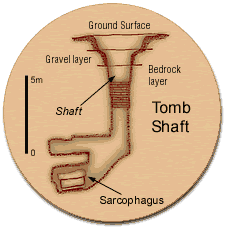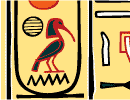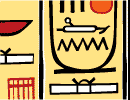Pinpointing the Targets
Our analyses pinpointed 38 sites of possible buried and unknown
constructions. Most, however, were under military control or within the
concession areas of other archaeological teams. Following the trails our
analyses laid out, however, confirmed that at least four of those targets
did indeed contain unreported remains of ancient monuments.
|

|
This diagram shows the
location of the unfinished sarcophagus discovered in the bottom
chamber of the tomb.
|
Ground surveys at two sites near the pyramid of Kendjer revealed
surface deposits of limestone fragments and other artificial objects,
including three stone coffins. A third site, dated to the New Kingdom, was
in an almost completely flat stretch of desert. A strong backscatter,
however, revealed a mud-brick architectural complex, covered by a thin
layer of sand, with many surface deposits. Though a worthy site, it was
ignored in our study, since pyramids apparently were not being built at
Dahshur during the New Kingdom. That left the site we designated No. 35 —
roughly 30 kilometers (18.5 miles) south of Cairo and two kilometers (1.2
miles) northeast of Snefru's Red Pyramid. This was the site we chose to
excavate.
The high-resolution optical image from the KVR-1000 satellite revealed
three circular hollows in a diagonal line similar to the pyramid formation
of Giza. These circular hollows mostly are typical of collapsed or
unfinished pyramids, as determined in our baseline study, and the site is
surrounded by Old and Middle Kingdom monuments.
The Landsat and SPOT images also showed strong reflections around
pyramid and limestone constructions, and surface deposits were found
during the ground surveys.
The Tomb in the Sand
We began excavating the site, named "Dahshur North," in March 1996. The
most conspicuous discovery was a mud-brick tomb of the New Kingdom period
that is 47 meters (154 feet) long, comparable to the largest tomb-chapel
of Horemheb at Saqqara. It was built on the central hilltop of the site,
where soft limestone chips were scattered on the surface. The upper part
of the tomb was mostly gone, but the floor plan included a ramp,
courtyards, and a chapel with side rooms.
Although the tomb was not a pyramid complex, we discovered a limestone
pyramidion (a capstone) about 60 centimeters (2 feet) tall. It almost
certainly was designed to sit atop the tomb-chapel.
We also unearthed a shaft entrance and several underground chambers
(about 13 meters, 43 feet, below the surface). The shaft was elaborately
lined with limestone blocks and leads to seven underground chambers. A
huge granite sarcophagus was found in the innermost chamber.
[an error
occurred while processing this directive]
So far, we have recovered more than 4,000 artifacts that suggest the
tomb is from the late-eighteenth or early-nineteenth dynasty. Such royal
names as Akhenaten, Tutankhamun, his wife Ankhesenamun, and Rameses II
were written on some objects. The size and elaborate construction of the
tomb imply that the owner must have been a high official connected to the
royal family.
In any event, this is the first New Kingdom monument reported in the
Dahshur area. This excavation is noteworthy for its archaeological
discovery, but even more for demonstrating the value of space archaeology
in surveying the Egyptian desert for sites that are invisible from the
ground. The eyes in the sky, if utilized by Egyptologists, promise many
more discoveries in the years ahead.
TOSHIBUMI SAKATA and MASAHIRO ETAYA are with Tokai University Research
& Information Center in Tokyo.
SAKUJI YOSHIMURA, JIRO KONDO, and SO HASEGAWA are with the Egyptian
Culture Center of Waseda University.





